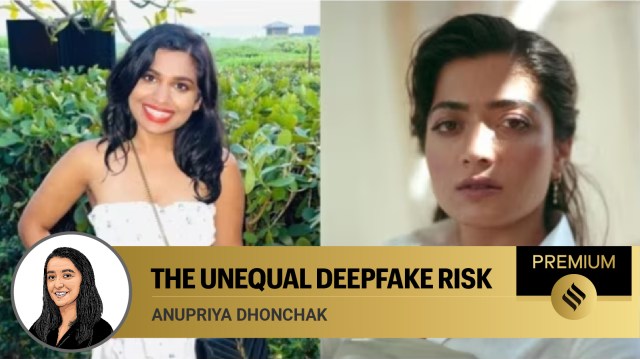
Recently, a deepfake video of actor Rashmika Mandanna went viral on X, formerly Twitter, and multiple other social media platforms. A video posted by British-Indian influencer Zara Patel was morphed to splice Mandanna’s head onto Patel’s body.
As digital platforms proliferate in an attention economy, the dissemination of deepfakes with unprecedented speed and finesse, at little to no cost to the creators, has already increased the sexualisation and objectification of women online exponentially. The sophistication of deepfake technology makes deception easy. The ease of its availability and use without the requirement of any expertise makes detection difficult.
Women’s exercise of bodily autonomy invites disproportionate shame and stigma in India. Societally defined gender, caste, age, and class roles determine women’s mobility, making their access to masculine public spaces conditional, requiring adherence to a behavioural code of conduct. The online sphere where the average internet user may not fully understand what “Terms of Use” she is “consenting” to, further complicates this spatial register.
Women’s unwilling embodiment online has been termed a “double embodiment”. Women are disproportionately “bodied”, that is, over-identified with their physical characteristics as compared to men in the offline world. Similar objectification awaits them online. Thus, women’s loss of liberty in cyberspace is a second loss, exacerbating the impact of their offline social subordination. The online realm amplifies the potential for discrimination by activating the internet’s discriminatory stereotypes and social scripts at a seismic and systemic scale.
Against this context, women who post videos and photos of themselves to their social media accounts should not be considered to have consented to any and all subsequent uses of their depictions just because their social media accounts have not been set to “private”.
Social media content creation today has emerged as a form of gig work. While participants can view it as a natural medium for self-expression, platform design also enables the monetisation of content, audiences, and skills. The concept of honour in India is closely tied to ideas of possession — control of and ownership over women’s bodies. Women on social media often reject this concept by reworking the dominant frames that regard them as sexualised property. They navigate heteronormative and capitalist metrics of value on social media for their profit.
However, allowing attention-grabbing deepfakes that profit off of the male gaze generates higher advertisement revenues for platforms by driving up engagement and harming vulnerable users. Apart from causing economic, physical, and/or psychological harm to victims, it stifles their right to free speech, forcing them to often shut down their profiles and withdraw from all publicity. This restricts women’s access to the technological means of production in an age of informational capitalism, which combines neoliberal governance with reliance on users’ cognitive input and affective labour.
According to research by IT for Change, in India, one-third of the women surveyed reported that they had faced harassment, abuse, or unwanted behaviour online and two-fifths were aware of other women in their circles who had similar experiences. Ninety per cent of the survey respondents who had faced harassment reported having faced it on multiple occasions. The misogynistic vitriol faced by Dalit women was unsurprisingly casteist as well. Further, data indicating a wide gap between male and female users of social media platforms reveals the starkly gendered digital divide in the country.
For instance, as per Instagram demographics, around 27.5 per cent of Instagram users in India are women, while most users (around 72.5 per cent) are men.
The Supreme Court in K S Puttaswamy v Union of India noted that “people do not want to…become inaccessible as much as they want their information to be treated in accordance with their expectations”. Women do not want to retreat from publicity, and they should not be forced to. Especially when the Supreme Court has afforded express legal recognition to privacy interests in public spaces by observing that “if dignity is the underlying feature, the basis of recognising the right to privacy is not denuded in public spaces”. Hence, when a social media user’s post is deepfaked by a third party, concerns regarding consent to the visibility of one’s persona in unanticipated contexts get implicated along with the inequality of bargaining power and informational asymmetries to constitute a violation of the user’s right to privacy.
As per the prevailing legal position, moderation policies and platform design focus largely on negative freedoms (freedom from). However, there is a need to evolve frameworks which also promote positive freedoms (freedom for), such as the right to (equal) public participation, or the right to publicness.
In her tweet, responding to the deepfake video, Mandanna emphasised the support that she received as an actor and candidly expressed that had this happened to her when she was in school or college, she would not have been able to tackle it. In a similar vein, the Delhi High Court in Indu Jain v Forbes Incorporated had held that celebrities are in a better position to counter any loss of reputation suffered by them in the marketplace of ideas whereas those with fewer/restricted means may not be able to do the same. The virality, instantaneity, anonymity and permanence afforded by the use of generative AI in an unforgiving online medium renders all of us terrifyingly vulnerable. But not all of us are equally vulnerable.
Therefore, any legal framework to tackle deepfakes must be sensitive to the burdens that women and other minorities disproportionately bear to access the benefits of publicity (fortune, fame, money), their additional vulnerability to exploitation by others, and the incorrectly presumed renunciation of their rights once they choose to commodify some aspects of their identities online.
The writer is a lawyer and Rhodes Scholar from India and is currently pursuing an MPhil in (Intellectual Property) Law at the University of Oxford